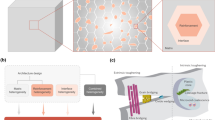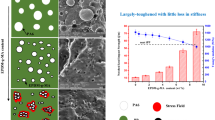Brittle nature and poor resistance in front of vibrational waves despite of good mechanical strength have limited widespread use of epoxy resins in industry. In current study a new combination of thermoplastic and particulate nanofiller is used as modifier to enhance simultaneously tensile strengths and damping properties in first and second modes of epoxy-based nanocomposite. High impact polystyrene (HIPS) as thermoplastic phase and silica nanoparticles as particulate phases incorporately used to obtain ternary epoxy-based nanocomposite. In current study solution blending as dispersion mechanism is used to prepare homogenous mixture and brings good molecular level of mixing. Tensile and damping properties in first and second modes were the two different mechanical tests investigated in order to achieve higher toughness strengths without attenuating desired mechanical properties. Also central composite design is employed to present mathematical models for predict mechanical behaviors of epoxy/HIPS/silica nanocomposite as function of physical factors. The effective parameters investigated were HIPS, SiO2, and hardener contents. Based on mathematical functions obtained from central composite design model, the genetic algorithm as one of powerful optimization tools is applied to find optimum values of mentioned mechanical properties. From the results it can be found that combination of HIPS and silica nanoparticles significantly increased tensile and damping strengths of epoxy resin up to 69, 42, and 91%, respectively. The morphology of fracture surface is also studied by scanning electron microscopy.










Similar content being viewed by others
References
M. M. Shokrieh, M. A. Torabizadeh, and A. Fereidoon, “A new method for evaluation of mechanical properties of glass/epoxy composites at low temperatures,” Strength Mater., 44, No. 1, 87–99 (2012).
M. M. Shokrieh, M. A. Torabizadeh, and A. Fereidoon, “Progressive failure analysis of glass/epoxy composites at low temperatures,” Strength Mater., 44, No. 3, 314–324 (2012).
A. V. Buketov, P. D. Stukhlyak, V. V. Levyts’kyi, et al., “A study of creep of epoxy composites with continuous fibers and modified fine filler in aggressive media,” Strength Mater., 43, No. 3, 338–346 (2011).
H. Kishi, M. Kuwata, S. Matsuda, et al., “Damping properties of thermoplastic-elastomer interleaved carbon fiber-reinforced epoxy composites,” Compos. Sci. Technol., 64, 2517–2523 (2004).
A. J. Kinloch, M. L. Yuen, and S. D. Jenkins, “Thermoplastic-toughened epoxy polymers,” J. Mater. Sci., 29, 3781–3790 (1994).
R. D. Brooker, A. J. Kinloch, and A. C. Taylor, “The morphology and fracture properties of thermoplastic-toughened epoxy polymers,” J. Adhes., 86, Issue 7, 726–741 (2010).
E. H. Rowe, A. R. Siebert, and R. S. Drake, “Toughening thermosets with butadiene/acrylonitrile polymers,” Mod. Plast., 47, 110–117 (1970).
A. J. Kinloch, S. J. Shaw, D. A. Tod, and D. L. Hunston, “Deformation and fracture behaviour of a rubber-toughened epoxy: 1. Microstructure and fracture studies,” Polymer, 24, Issue 10, 1341–1354 (1983).
R. A. Pearson and A. F. Yee, “Toughening mechanisms in elastomer-modified epoxies,” J. Mater. Sci., 21, 2475–2488 (1986).
N. G. Yun, Y. G. Won, and S. C. Kim, “Toughening of epoxy composite by dispersing polysulfone particle to form morphology spectrum,” Polym. Bull., 52, 365–372 (2004).
M. Kimoto and K. Mizutani, “Blends of thermoplastic polyimide with epoxy resin: Pt. II. Mechanical studies,” J. Mater. Sci., 32, 2479–2483 (1997).
A. Mirmohseni and S. Zavareh, “Preparation and characterization of an epoxy nanocomposite toughened by a combination of thermoplastic, layered and particulate nano-fillers,” Mater. Des., 31, No. 6, 2699–2706 (2010).
K. Mimura, H. Ito, and H. Fujioka, “Improvement of thermal and mechanical properties by control of morphologies in PES-modified epoxy resins,” Polymer, 41, Issue 12, 4451–4459 (2000).
L. R. F. Rose, “Toughening due to crack-front interaction with a second-phase dispersion,” Mech. Mater., 6, Issue 1, 11–15 (1987).
K. T. Faber and A. G. Evans, “Crack deflection processes – II. Experiment,” Acta Metall., 31, No. 4, 577–584 (1983).
J. Lee and A. F. Yee, “Inorganic particle toughening I: Micro-mechanical deformations in the fracture of glass bead filled epoxies,” Polymer, 42, No. 2, 577–588 (2001).
J. Lee and A. F. Yee, “Inorganic particle toughening II: Toughening mechanisms of glass bead filled epoxies,” Polymer, 42, No. 2, 589–597 (2001).
J. Lee and A. F. Yee, “Fracture of glass bead/epoxy composites: on micromechanical deformations,” Polymer, 41, Issue 23, 8363–8373 (2000).
T. Kawaguchi and R. A. Pearson, “The effect of particle–matrix adhesion on the mechanical behavior of glass filled epoxies. Pt. 2. A study on fracture toughness,” Polymer, 44, Issue 15, 4239–4247 (2003).
T. H. Hsieh, A. J. Kinloch, K. Masania, et al., “The mechanisms and mechanics of the toughening of epoxy polymers modified with silica nanoparticles,” Polymer, 51, Issue 26, 6284–6294 (2010).
C. Roscher, “Tiny particles, huge effect: Radiation curable silica nanocomposites for scratch and abrasion resistant coatings,” Eur. Coat. J., No. 4, 138–142 (2003).
R. A. Vaia, T. Benson Tolle, G. F. Schmitt, et al., “Nanoscience and nanotechnology: materials revolution for the 21st century,” SAMPE J., 37, 4–31 (2001).
E. T. Thostenson, C. Li, and T.-W. Chou, “Nanocomposites in context,” Compos. Sci. Technol., 65, 491–516 (2005).
B. Wetzel, F. Haupert, K. Friedrich, et al., “Impact and wear resistance of polymer nanocomposites at low filler content,” Polymer Eng. Sci., 42, Issue 9, 1919–1927 (2002).
H. Zou, S. Wu, and J. Shen, “Polymer/silica nanocomposites: preparation, characterization, properties, and applications,” Chem. Rev., 108, 3893–3957 (2008).
A. Asif, K. Leena, V. Lakshmana Rao, and K. N. Ninan, “Hydroxyl terminated poly(ether ether ketone) with pendant methyl group-toughened epoxy clay ternary nanocomposites: preparation, morphology, and thermomechanical properties,” J. Appl. Polymer Sci., 106, Issue 5, 2936–2946 (2007).
H. Zhang, L. A. Berglund, “Deformation and fracture of glass bead/CTBN-rubber/epoxy composites,” Polymer Eng. Sci., 33, Issue 2, 100–107 (1993).
J. Lee and A. F. Yee, “Micro-mechanical deformation mechanisms in the fracture of hybrid-particulate composites based on glass beads, rubber and epoxies,” Polymer Eng. Sci., 40, Issue 12, 2457–2470 (2000).
F. Ravari, A. Omrani, A. A. Rostami, and M. Ehsani, “Ageing effects on electrical, morphological, and mechanical properties of a low viscosity epoxy nanocomposite,” Polymer Degrad. Stab., 97, No. 6, 929–935 (2012).
A. Omrani, L. C. Simon, A. A. Rostami, and M. Ghaemy, “Cure kinetics, dynamic mechanical and morphological properties of epoxy resin–Im6NiBr2 system,” Eur. Polymer J., 44, No. 3, 769–779 (2008).
A. Omrani, L.C. Simon, and A. A. Rostami, “Influences of cellulose nanofiber on the epoxy network formation,” Mater. Sci. Eng. A, 490, 131–137 (2008).
R. Leardi, “Experimental design in chemistry: a tutorial,” Anal. Chim. Acta, 652, 161–172 (2009).
P. Angelopoulos, H. Evangelaras, and C. Koukouvinos, “Small, balanced, efficient and near rotatable central composite designs,” J. Statist. Plan. Infer., 139, No. 6, 2010–2013 (2009).
J. S. Chung and S. M. Hwang, “Application of a genetic algorithm to the optimal design of the die shape in extrusion,” J. Mater. Process. Technol., 72, No. 1, 69–77 (1997).
R. G. Song and Q. Z. Zhang, “Heat treatment optimization for 7175 aluminum alloy by genetic algorithm,” Mater. Sci. Eng. C, 17, Issues 1-2, 133–137 (2001).
R.-G. Song, Q.-Z. Zhang, M.-K. Tseng, and B.-J. Zhang, “The application of artificial neural networks to the investigation of aging dynamics in 7175 aluminium alloys,” Mater. Sci. Eng. C, 3, Issue 1, 39–41 (1995).
P. van Overschee and B. de Moor, Subspace Identification for Linear Systems. Theory–Implementation– Applications, Kluwer Academic Publishers, Dordrecht (1996).
B. Peeters, System Identification and Damage Detection in Civil Engineering, Ph.D. Thesis, Katholieke Universiteit Leuven, Belgium (2000).
A. R. Brincker and P. Andersen, “Understanding stochastic subspace identification,” in: Proc. of International Modal Analysis Conference (IMAC), Denmark (2006), pp. 461–466.
E. Morgan (Ed.), Chemometrics: Experimental Design, Wiley, Chichester (1995).
M. Hadjmohammadi and V. Sharifi, “Simultaneous optimization of the resolution and analysis time of flavonoids in reverse phase liquid chromatography using Derringer’s desirability function,” J. Chromatogr. B, 880, 34–41 (2012).
A. Mirmohseni and S. Zavareh, “Modeling and optimization of a new impact-toughened epoxy nanocomposite using response surface methodology,” J. Polymer Res., 18, 509–517 (2011).
A. Mirmohseni and S. Zavareh, “Epoxy/acrylonitrile-butadiene-styrene copolymer/clay ternary nanocomposite as impact toughened epoxy,” J. Polymer Res., 17, No. 2, 191–201 (2010).
Y. Huang and A. J. Kinloch, “Modelling of the toughening mechanisms in rubber-modified epoxy polymers,” J. Mater. Sci., 27, Issue 10, 2763–2769 (1992).
A. F. Yee and R. A. Pearson, “Toughening mechanisms in elastomer-modified epoxies,” J. Mater. Sci., 21, 2462–2474 (1986).
J. López, C. Ramirez, M. J. Abad, et al., “Blends of acrylonitrile–butadiene–styrene with an epoxy/ cycloaliphatic amine resin: phase-separation behavior and morphologies,” J. Appl. Polymer Sci., 85, Issue 6, 1277–1286 (2002).
Y. Müller, L. Häuβler, and J. Pionteck, “ABS-modified epoxy resins – curing kinetics, polymerization induced phase separation, and resulting morphologies,” Macromolec. Symp., 254, Issue 1, 267–273 (2007).
Author information
Authors and Affiliations
Corresponding author
Additional information
Translated from Problemy Prochnosti, No. 5, pp. 146 – 165, September – October, 2013.
Rights and permissions
About this article
Cite this article
Rostamiyan, Y., Fereidoon, A.B. Preparation, Modeling, and Optimization of Mechanical Properties of Epoxy/HIPS/Silica Hybrid Nanocomposite Using Combination of Central Composite Design and Genetic Algorithm. Part 1. Study of Damping and Tensile Strengths. Strength Mater 45, 619–634 (2013). https://doi.org/10.1007/s11223-013-9499-1
Received:
Published:
Issue Date:
DOI: https://doi.org/10.1007/s11223-013-9499-1




